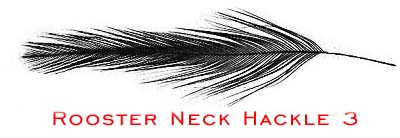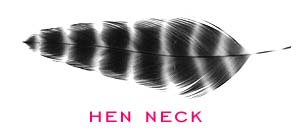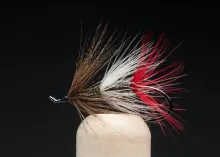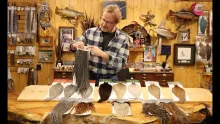One of the things most often asked by neophyte streamer tyers is what types of hackle are best suited for streamer wings. The short answer is... there is no single source best suited for streamer wings. The long answer... well... I'll ramble on about it for the remainder of this essay!

One of the things most often asked by neophyte streamer tyers is what types of hackle are best suited for streamer wings. The short answer is.....there is no single source best suited for streamer wings. The long answer... well... I'll ramble on about it for the remainder of this essay!
The question asked above is actually a bit of a tricky question, because the term "streamer" is used so broadly. For my purposes, I'll describe a streamer as those patterns intended to represent forage fish. Within this category of "forage fish", we find a wide variety of species, and a wide range of sizes within each species. As streamer anglers, we need to determine both which species, and what size baitfish our target game fish are most interested in feasting on. We also need to consider what methods we might use to present our pattern to the fish, i.e. Trolling or Casting.
While knowing the species of forage fish is a must to be successful, our choice of hackle will most often be dictated by the size of the pattern we are creating. Below are the most commonly available hackles, and some comments about about their suitability for streamer patterns.
Left, Right, and Neutral Hackles
All hackles, regardless of the source they come from, that are used for winging streamers fall into one of these three categories which indicate the side of the streamer they are appropriate for. I've always known about left and right hackles, but never really thought about a term for those suited for use on either side. I had a conversation with Mike Martinek one evening where he called these multi-purpose hackles "neutral" hackles, and I think the name is appropriate.
To determine which category a hackle falls into, simply pick up the feather by the stem and hold it horizontally, as it would be placed as a streamer wing. The stem of most hackles have a "spine" to them on one side or the other (similar to the spine of a rod blank). Rotate the stem in your fingers, until the hackle flips 180 degrees, and notice which direction causes the feather to become "droopier". You don't want your wing to droop, so it's normally a very clear indication as to which side the hackle belongs on. Those that don't show an appreciable droop in either direction are the "neutral" hackles, and can be used on either side.
The Saddle Hackle:
The Saddle Hackle is the best choice for larger patterns. I would qualify the term "larger" as being those patterns tied on size 6, 8X long or larger hooks, and tandem trolling streamers. This feather comes from the "saddle" of the chicken....cut from a spot on its back between the wings, from the base of the neck towards the base of the tail.

The stems of this feather are probably the smallest, and most flexible of the other feathers which I'll mention here. A good saddle hackle has a moderate amount of "web", which is that portion of the feather that appears "stuck together", or married. The web appears as the darker "V" shape along the stem in the illustration above. The web of a feather provides a certain amount of rigidity to the hackle, allowing it to retain its form when fished. Too much web is not a good thing however, as it restricts the movement of the feather barbules in the water. The barbules are quite dense and fine in diameter on a quality saddle hackle as well.
Saddle hackles are THE hackle of choice for tying patterns larger than size 6 in the Rangeley Style. Unfortunately for streamer tyers....the top-notch saddle hackles are hard to come by today due to the demand for "dry-fly" quality hackle, which has the exact opposite properties we want for a streamer hackle...they want short barbs and no web. Much of the saddle hackle used by streamer tyers in the past came as a by-product of the poultry business, particularly the smaller operations, which have been put out of business by the large "chicken machines" like Tyson, etc. Companies like that are not much interested in the small revenues that could be gained by providing saddle patches to the fly tying community.
Examples from this site using only saddle hackles for the wings are the Gray Ghost and the Greyhound.
The Rooster Neck Hackle:
The quality of neck hackles varies quite a bit with regards to their suitability as a streamer hackle. They are generally best suited for streamers smaller than size 6 - 8X long, though this isn't a hard and fast rule. One thing to keep in mind however is that the neck hackle barbules are typically much longer, and sharply-angled to the stem than those on a saddle hackle as shown below:

This can cause the front of the streamer to appear "collapsed", but can often be compensated for and camouflaged by using a stiffer shoulder feather in a pattern.

This example of a neck hackle comes from a half-cape I bought at Walmart when they tried selling fly tying materials. They were marketing this thing as a dry fly neck, but it obviously doesn't suit that purpose. I've used a bit of it for smaller casting-sized "wing on top" patterns such as the Black Ghost. It's all it's really good for. Notice the thicker barbule diameter, and lack of tightly-knit web. Wet this thing, and it absolutely collapses, but because it is still loosely-married together, it doesn't have very good action in the water.

Neck Hackle number 2 comes from an Orvis "Saltwater neck". It has a much better web than the Wally-world version, and holds its shape nicely when wet, though not nearly as well as the quality saddle hackle. I own quite a few of these necks in various colors, and it's my choice for smaller (8-12) casting-sized streamers, and even larger patterns which call for the wings to be "set on top". Another use I have for these is as the inner pair of hackles in Rangeley Style streamers...used in conjunction with a nice pair of saddle hackles to hide their thicker barbules, they provide the "inner colors" for many of my larger streamers. The Lady Miller pattern illustrated in my Carrie Stevens feature uses this combination of neck and saddle hackles. Two other drawbacks to these, and all hen neck hackles, is that they tend to have a strong curvature, and thick stem, which makes them stiffer than saddle hackles, and provides bulk at the head of the streamer. They also have a tendancy to "roll over" when tied on due to the shape of the stem cross-section. With some effort, they are very useful though, and a certain number of these hackles from a typical neck can be used to produce some nice-looking streamers. The Allie's Favorite and Wizard patterns illustrated on this site use only these saltwater neck hackles for their wings.

Here's another example of a feather from an Orvis Saltwater neck. It's one of the smaller feathers from a different neck than the one illustrated above, but it's obviously not of the quality of the earlier neck hackle. This inconsistancy in quality of neck feathers is another large drawback to their use. All I'd consider using this one for would be to add a collar to a larger streamer.

The grizzly neck hackle shown above is one of the best-quality neck patches I've found. It was marked as a "domestic neck", and is I bought it because it had nice barring and a decent amount of web in the hackles. I'm using it here to illustrate another drawback of neck hackles however....the pointed tip. Since I don't have a decent grizzly saddle though, I am currently using this neck to provide all my grizzly hackle for streamers. I simply do a little creative snipping with the scissors to round the tip a bit near the end, in one of the dark-bars. So I cheat. Every pattern illustration in the Carrie Stevens Feature with grizzly hackle in the wing utilizes this type of hackle, either alone or in combination with saddle hackles. The General MacArthur and Golden Witch are two examples of this hackle in use.

I picked up a few Chinese and Indian Rooster Necks with hackles such as the one shown above in both silver and golden badger. I love using badger hackles for streamer patterns...the dark center stripe provides a wonderful indication of a minnow-shape or lateral line, but it's hard to find quality badger saddles on the market. Most that I've seen have had hackles way too narrow for larger patterns. I use these chinese badger neck hackles for casting-sized streamers, particularly dace immitations. Patterns on this site utilizing this type of hackle include the Green Hornet, the Battenkill Shiner, and the Copper Candy.
Other Hackles:

This is a Metz Grizzly Hen Neck hackle. As you can see, it's nearly all-web. In it's current state, it has very little action in the water and will pretty much keep this shape. It could be used for a Matuka-style streamer wing, however, and it's a top choice for wet fly or streamer collars in my book, as it's soft and pulses when the barbules are "unzipped". It also works very well as a shoulder feather for Rangeley Style trolling streamers.

A very cool feather, but only marginally suited for streamer wings due to its short barbule length and stiff stem. Like the grizzly hen neck feather, a wonderful shoulder feather for larger trolling streamers, found in such famous patterns as Carrie Stevens' Greyhound and Lady Miller.

Schlappen is not really suited as a streamer wing material, as it's nearly all web. The fibers are very handy for use in constructing tails and throats on streamer patterns however. Mike Martinek makes extensive use of the barbules of schlappen feathers in constructing Rangeley Style patterns. Tied on after adding a bucktail throat on a pattern, this material will help keep the material pointed where you want it to go. It also prevents the head and shoulders of the pattern from collapsing, giving the front of the pattern a meatier appearance.
Obviously, there are a wide variety of other feathers that can be used for streamer wings, but these are the most-commonly used types. I hope this feature provided a little food for thought in your tying endeavors.
- Log in to post comments








hello i hope you are
hello i hope you are haveing a good day thank you for putting this site on line for use to read i live in the uk. kent. i have not long got into fly tying and i thing the best pattern is the streamer for what i am trying to fish with i am going to be fishing for bass in salt water this summer comeing looking forward to tying some streamers from your site thanks will save this site now hope you have a nice day all the best